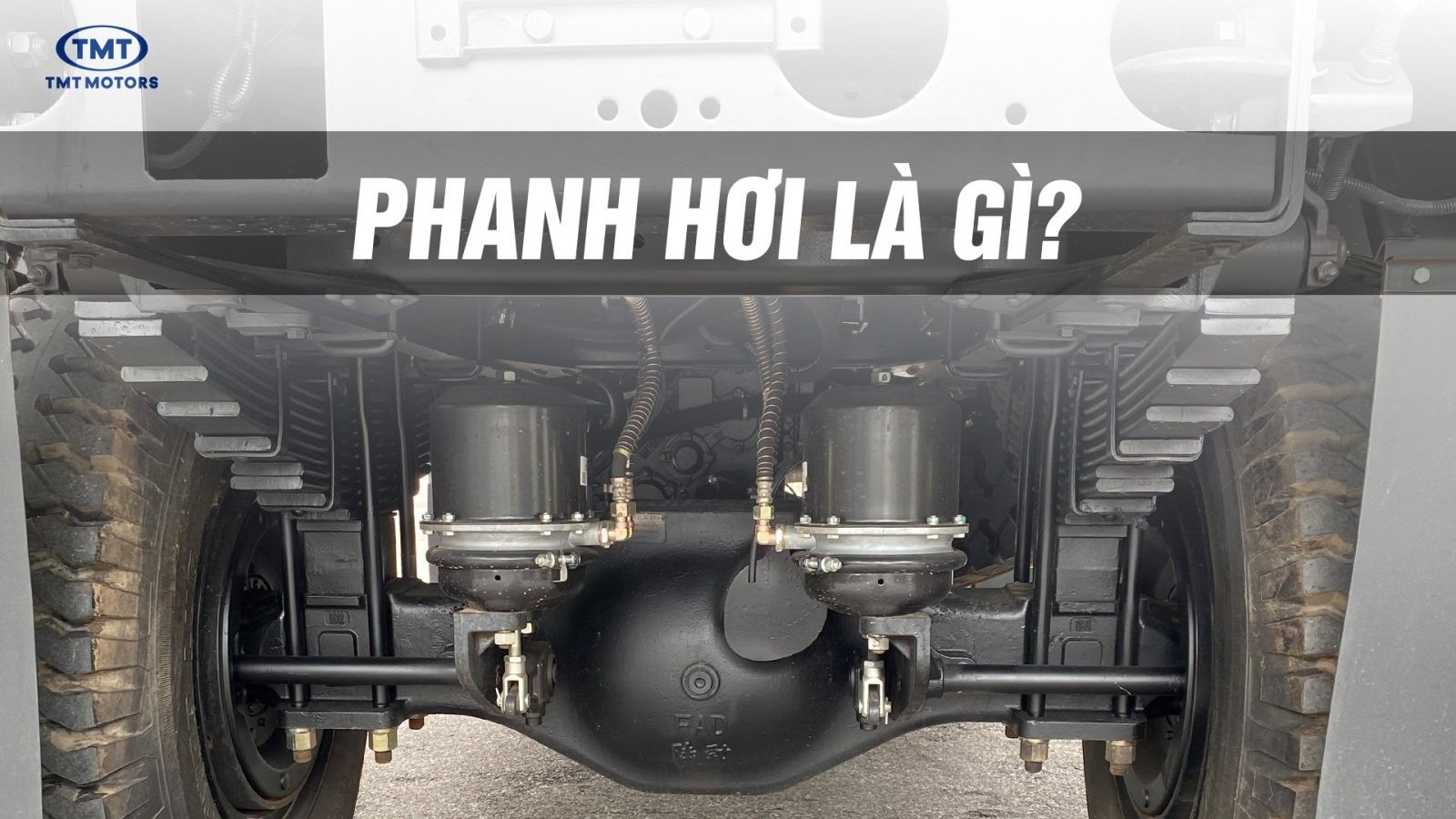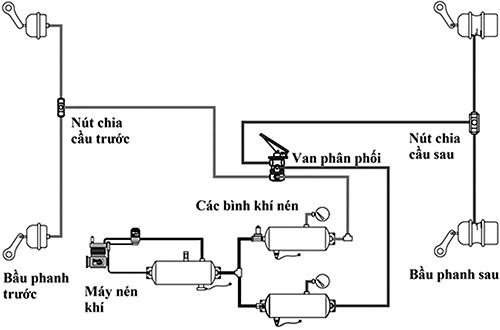Air brake systems are crucial for ensuring the safety of trucks, especially heavy-duty vehicles commonly used in Vietnam. Unlike conventional hydraulic brakes, air brakes rely on compressed air for operation. Therefore, mastering the correct truck air brake operation is essential for drivers to effectively and safely control their vehicles on every journey. This article from Xe Tải Mỹ Đình will provide you with a detailed guide on how to use truck air brakes, from the operating principles to safe driving techniques, helping you confidently master your truck.
What Are Truck Air Brakes?
 Illustration of a truck air brake system
Illustration of a truck air brake system
Truck air brakes, also known as pneumatic brakes, are braking systems that use compressed air pressure to generate friction force to slow down the wheels. This system is particularly suitable for heavy-duty trucks, buses, tractor-trailers, container trucks, and other large cargo vehicles. The outstanding advantage of air brakes is their ability to generate strong and stable braking force, helping vehicles decelerate and stop safely even when heavily loaded or traveling on challenging terrain.
How Truck Air Brakes Work
 Diagram illustrating the operating principle of a truck air brake system
Diagram illustrating the operating principle of a truck air brake system
Truck air brake systems operate based on the principle of compressed air. When the vehicle is started, the air compressor begins to generate compressed air and store it in air tanks. The process of operating truck air brakes is as follows:
- Depressing the brake pedal: When the driver presses the brake pedal, the brake control valve opens.
- Compressed air is released: Compressed air from the air tank is released and transmitted to the brake chambers at each wheel.
- Actuation of brake shoes: The air pressure in the brake chamber acts on the piston, pushing the brake shoes firmly against the brake drum or brake disc.
- Generating friction force: The friction between the brake shoes and the brake drum/disc creates a braking force, reducing the rotational speed of the wheels and stopping the vehicle.
- Releasing the brake pedal: When the brake pedal is released, the control valve closes, the compressed air is released, and springs pull the brake shoes back to their original position, allowing the wheels to rotate freely again.
How to Use Truck Air Brakes Correctly and Safely
To operate truck air brakes effectively and safely, especially for beginners, consider the following points:
- Check air pressure: Before starting, ensure the air pressure in the air tanks is sufficient according to the manufacturer’s specifications. Insufficient pressure can reduce braking efficiency and even cause brake failure.
- Apply firm and even pressure to the brake pedal: When braking, depress the brake pedal firmly and maintain even pressure. Avoid abrupt braking or repeatedly pumping the brakes, especially when the vehicle is heavily loaded or traveling at high speeds.
- Use engine brake for assistance: When descending hills or needing to decelerate gradually, combine the use of engine brake to reduce the load on the air brake system. Engine braking helps slow down the vehicle smoothly and prevents overheating of the brakes.
- “Pre-brake” before main braking: In certain situations, especially when entering curves or on slippery roads, “pre-brake” or “feather” the brakes, meaning to lightly depress the brake pedal to reduce speed and stabilize the vehicle before applying the main brakes.
- Pay attention to braking distance: Due to the large inertia of trucks, the braking distance is typically longer than that of cars. Always maintain a safe following distance and estimate the appropriate braking distance for each road condition and speed.
- Listen for brake system noises: During braking, pay attention to any noises from the brake system. Unusual noises may indicate worn brake pads, problems with the air system, or other component failures. Inspect and maintain the brake system promptly to ensure safety.
Advantages of Air Brakes Over Hydraulic Brakes
Compared to traditional hydraulic brake systems, truck air brakes offer several significant advantages:
- Stronger braking force: Air brakes generate greater braking force, suitable for heavy-duty and overloaded trucks.
- Higher reliability: Air brake systems are less affected by temperature and humidity, operating reliably in various harsh weather conditions.
- Enhanced safety: The risk of brake fluid leaks is eliminated, minimizing the chance of brake failure due to leakage. In the event of an air system malfunction, the brakes may still have self-braking capabilities for added safety.
- Even braking: Air brakes ensure even distribution of braking force across all wheels, helping the vehicle remain stable during hard braking.
Important Notes When Using Truck Air Brakes
- Regular maintenance: The air brake system requires regular maintenance according to the manufacturer’s recommendations, including inspecting air lines, air tanks, brake chambers, brake pads, and other components.
- Drain air tanks: Water condensation in the air tanks can cause corrosion and reduce braking efficiency. Drain the air tanks regularly, especially in humid weather conditions.
- Avoid overloading: Overloading not only affects the vehicle’s lifespan but also reduces braking efficiency and increases the risk of accidents. Adhere to the vehicle’s weight limits.
- Drive carefully: Although air brake systems are modern and safe, the driver’s skill remains a decisive factor. Always drive carefully, obey traffic laws, and maintain a safe following distance.
Conclusion:
Mastering the correct truck air brake operation techniques and understanding the operating principles of the air brake system are key factors in ensuring safety when operating a truck. We hope this article from Xe Tải Mỹ Đình has provided valuable information, helping you feel more confident and safe on every journey. If you have any further questions about trucks and brake systems, please contact us for detailed consultation.
